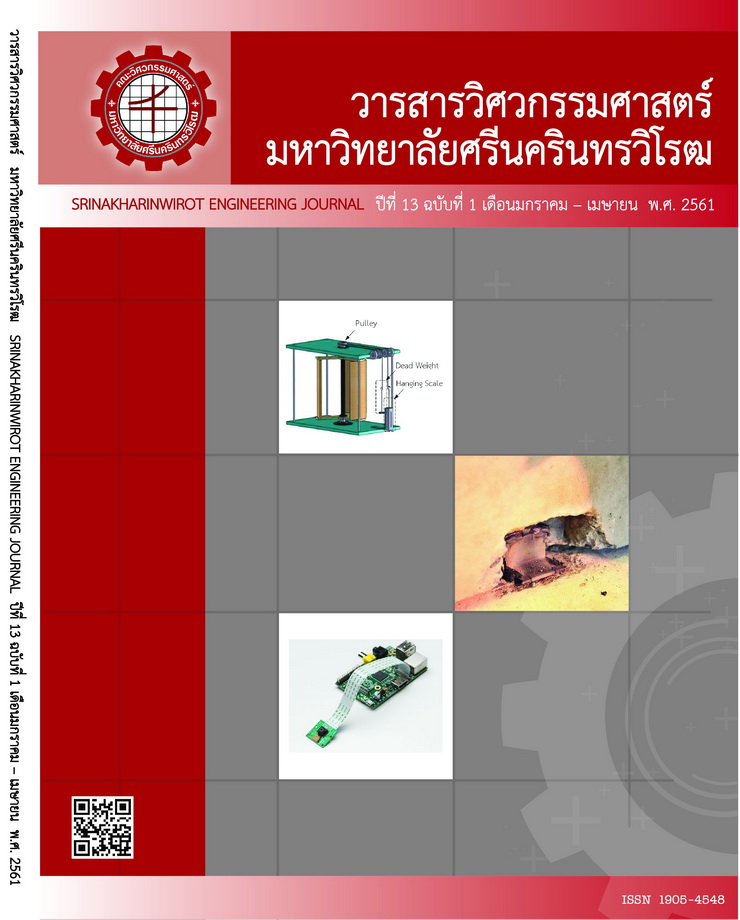Mechanical Properties of Local Cement-Clay Interlocking Bricks in Central Part of Thailand
Main Article Content
Abstract
This paper presents the findings of an experimental investigation performed on cement-clay interlocking (CCI) hollow bricks made using cement and clay, by conventional method. In Thailand, these CCI bricks are made in different regions by using locally available clay and there is no standard mix design to prepare bricks. Therefore, CCI brick samples were collected from different three regions of Thailand to study the influence of locally available clay and mix design ratio on the mechanical properties of CCI bricks. Mechanical properties such as compressive strength, splitting tensile strength, modulus of rupture and water absorption were determined. Results show that each region is following different mix design ratio based on availability of local materials and knowledge. It was also observed that locally available materials and mix design ratio has a significant effect on the mechanical properties of CCI bricks. The compressive strength of CCI bricks was observed between 4.22 MPa to 16.40 MPa. A large variation in the values of splitting tensile strength, modulus of rupture and absorption were also observed for different regions. This study indicates that there is an urgent need to establish and enforce standard guidelines for codes for CCI brick manufacturing process in Thailand.
Article Details
Copyright belongs to Srinakharinwirot University Engineering Journal
References
[2] Z. Ahmad, S. Z. Othman, B. Yunus, and A. Mohamed, “Behaviour of Masonry Wall Constructed using Interlocking Soil Cement Bricks.” World Acad. Sci. Eng. Technol., pp. 1263-1269, Dec. 2011.
[3] P. J. Walker, “Strength, durability and shrinkage characteristics of cement stabilised soil blocks,” Cem. Concrete Comp., vol. 17, pp. 301–310, 1995.
[4] B.V. Reddy and S. S. Lokras, “Steam-cured stabilised soil blocks for masonry construction,” Energy Buildings, vol. 29, no.1, pp. 29– 33, 1998.
[5] B. V. Redyy and A. Gupta “Characteristics of soil cement blocks using highly sandy soils,” Mater. Struct., vol. 38, no. 6, pp. 651-658, 2005.
[6] H. M. Kwon, A. T. Le and N. T. Nguyen “Influence of soil grading on properties of compressed cement-soil,” KSCE J. Civil Eng., vol. 14, no. 6, pp. 845-853, 2010.
[7] B. V. Reddy and P. P. Kumar “Cement stabilized rammed earth. Part A: compaction characteristics and physical properties of compacted cement stabilised soils,” Mater. Struct., vol. 44, no. 3, pp. 681-693, 2011.
[8] S. Kenai, R. Bahar and M. Benazzoug “Experimental analysis of the effect of some compaction methods on mechanical properties and durability of cement stabilized soil,” J. Mater. Sci., vol. 41, no. 21, pp. 6956-6964, 2006.
[9] P. Walker and T. Stace “Properties of some cement stabilized compressed earth blocks and mortar,” Mate. Struct., vol. 30, no. 9, pp. 545-551, 1997.
[10] A. W. Henry, B.P. Sinha and S.R. Davies, Design of masonry structures, London: E.& F.N.Spon, 1987.
[11] D. Lenczner, Elements of Load Bearing Brickwork. Oxford, Pergamon Press, 1972.
[12] R. C. Smith, Materials of Construction. New York,” McGraw-Hill Inc, 1973.
[13] S. Joseph, B. McGarry, B. Sajjakulnukit, and O.Sopchokchai, “A study of brick production in Thailand,” Issues on Women, Energy and the Environment, TDRI Quarterly Review, vol.5, no. 2, pp.11-15, 1990.
[14] F. R. Moormann, and S. Rojanasoonthon, “General Soil Conditions,” Land Development Department. The Applied Scientific Research Corporation of Thailand and FAO., Kasetsart Univ., Bangkok, Thailand, 1967.
[15] I. Demir, “Effect of organic residues addition on the technological properties of clay bricks,” Waste Manage., vol. 28, no. 3, pp. 622-627, 2008.
[16] V.Loryuenyong, T. Panyachai, K. Kaewsimork, and C. Siritai, “Effects of recycled glass substitution on the physical and mechanical properties of clay bricks,” Waste Manage, vol. 29, no. 10, pp. 2717-2721, 2009.
[17] Standard test methods for sampling and testing brick and structural clay tile, ASTM C 67-03, 2003.
[18] Standard Test Method for Splitting Tensile Strength of Masonry Units, ASTM C1006-07, 2007.
[19] Standard Test Methods for Sampling and Testing Concrete Masonry Units and Related Units, ASTM C140-11a, 2011.
[20] Standard Test Method for Compressive Strength of Masonry Prisms, ASTM C1314-14, 2014.
[21] Specification for Interlocking Block (Load-Bearing Type) (2004) TCPS: 602-2547, Bureau of Thai Industrial Standard, 2004.


